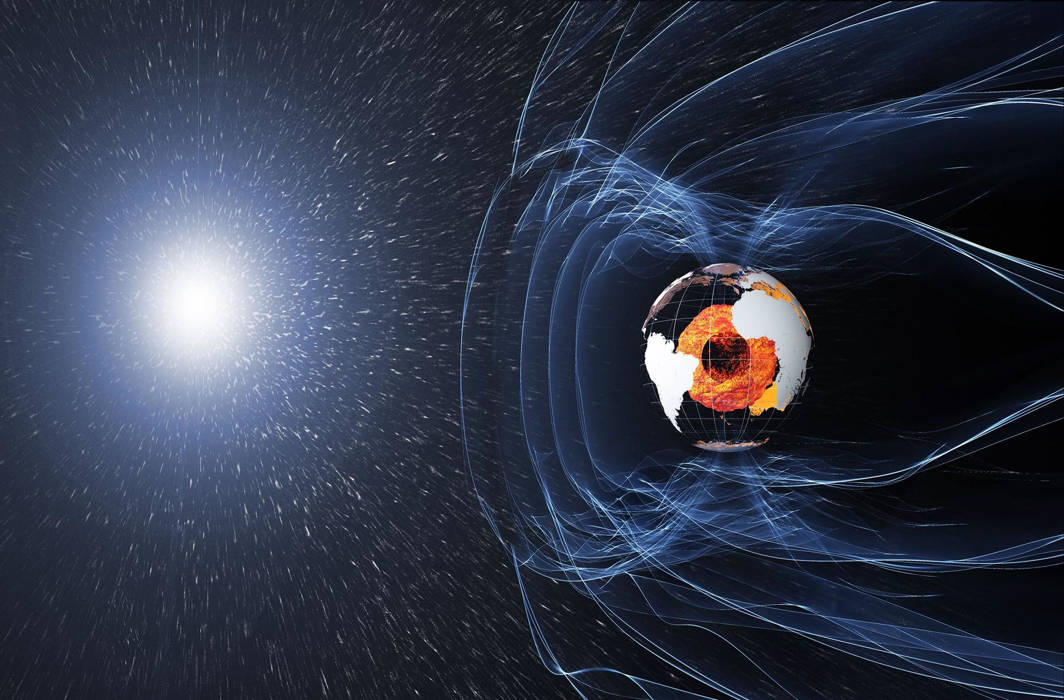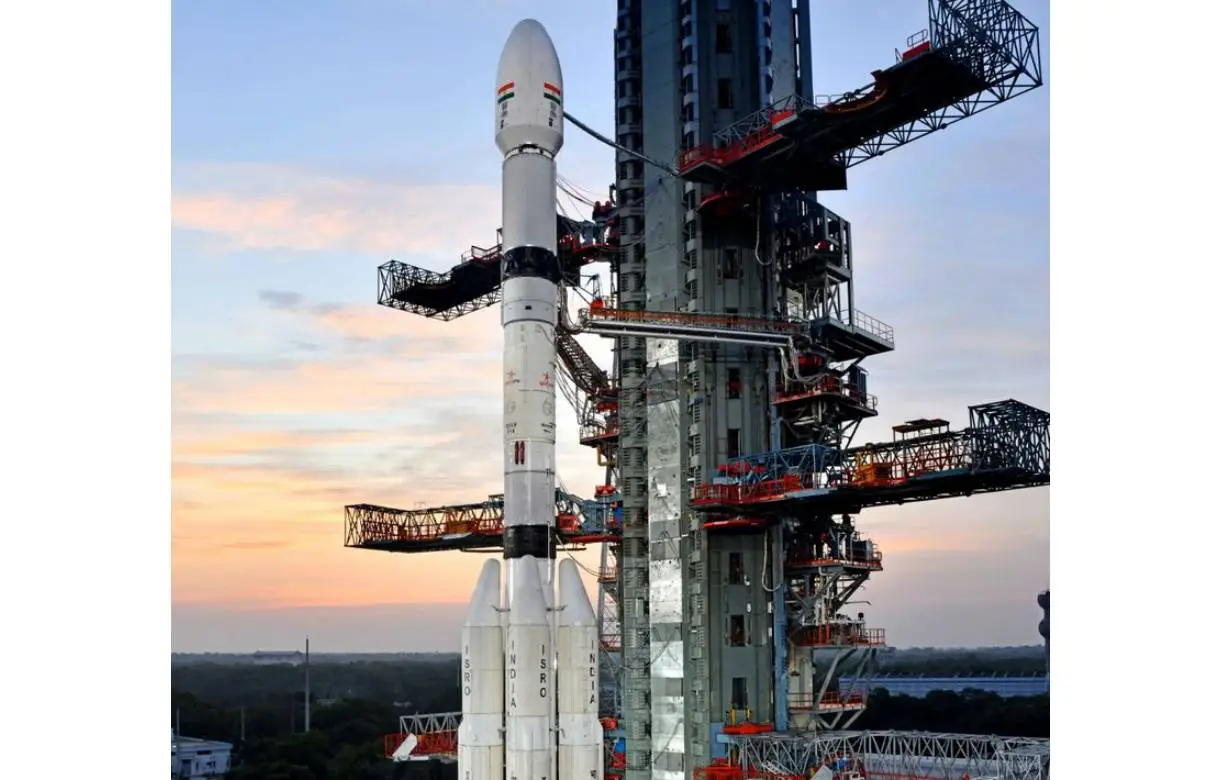Latest Science News
Magnetic North Pole moving 55 km a year, scientists update world magnetic model

[vc_row][vc_column][vc_column_text]On Monday, scientists released an update of where true north really was.
Such updates are nothing new and usually happen every five years, but this time it came nearly a year ahead of schedule because the Earth’s north magnetic pole is shifting fast – about 55 km a year – in the last few decades rendering past estimates no longer accurate enough for precise navigation.
The magnetic north pole crossed the international date line in 2017, and is leaving the Canadian Arctic on its way to Siberia. Its movement has become really fast – about five times its previous rate – and no one can explain why.
The constant shift is a problem for compasses in smartphones and some consumer electronics. Airplanes and boats also rely on magnetic north, usually as backup navigation, said University of Colorado geophysicist Arnaud Chulliat, lead author of the newly issued World Magnetic Model.
GPS isn’t affected because it’s satellite-based.
Magnetic north is one of three “north poles” on our globe. First, there’s true north, which is the northern end of the axis on which the Earth rotates.
But our planet’s protective magnetic bubble, or magnetosphere, isn’t perfectly aligned with this spin, explained National Geographic (NG). Instead, the dynamo of Earth’s core creates a magnetic field that is slightly tilted from the planet’s rotational axis. The northern end of this planet-size bar magnet is what’s known as geomagnetic north — a point sitting off the northwest coast of Greenland that’s changed position little over the last century.
Then there’s magnetic north, what your compass locates, which is defined as the point at which magnetic field lines point vertically down. Unlike geomagnetic north, this position is more susceptible to the surges and flows in the swirl of liquid iron in the core, said NG. These currents tug on the magnetic field, sending magnetic north hopping across the globe.
The military depends on where magnetic north is for navigation and parachute drops, while NASA, the Federal Aviation Administration, and the US Forest Service also use it.
Airport runway names are based on their direction toward magnetic north and their names change when the poles move. For example, the airport in Fairbanks, Alaska, renamed a runway 1L-19R to 2L-20R in 2009.
The US and the United Kingdom tend to update the location of the magnetic north pole every five years in December, but this update came early because of the pole’s faster movement.
Since 1831 when it was first measured in the Canadian Arctic, the magnetic north pole has moved about 2300 kilometers toward Siberia. Its speed jumped from about 11 km per year to 55 km per year since 2000.

The reason is turbulence in Earth’s liquid outer core about 2897 km below the surface. There is a hot liquid ocean of iron and nickel in the planet’s core and its motion generates an electric field, said University of Maryland geophysicist Daniel Lathrop, who wasn’t part of the team monitoring the magnetic north pole.
The magnetic south pole is moving far slower than the north.
In general Earth’s magnetic field is getting weaker, leading scientists to say that it will eventually flip, where north and south pole changes polarity, like a bar magnet flipping over. It has happened numerous times in Earth’s past, but not in the last 780,000 years.
“It’s not a question of if it’s going to reverse, the question is when it’s going to reverse,” Lathrop said. When it reverses, it won’t be like a coin flip, but take 1,000 or more years, experts said.
Lathrop sees a flip coming sooner rather than later because of the weakened magnetic field and an area over the South Atlantic has already reversed beneath Earth’s surface.
It is only in recent years, scientists noticed, that magnetic north’s movement has shifted into high gear, sending it galloping across the Northern Hemisphere — and no one can entirely explain why.
The changes have been so large that scientists began working on an emergency update for the World Magnetic Model, the mathematical system that lays the foundations for navigation, from cell phones and ships to commercial airlines. But then the US government shut down, placing the model’s official release on hold, as Nature News first reported earlier this year.
Finally, the World Magnetic Model update was officially released on Monday, and magnetic north can again be precisely located for people around the world.
The World Magnetic Model
To account for the periodic shift of magnetic north, the World Magnetic Model was developed by the US National Oceanic and Atmospheric Administration (NOAA) and the British Geological Survey (BGS) “so they would all be on the same map, essentially,” says Ciaran Beggan, a geophysicist with the BGS.
The model is updated every five years, with the last update in 2015. Between each update, scientists check the model’s accuracy against data from ground magnetic observatories and the European Space Agency’s Swarm mission—a trio of magnetic-field mapping satellites that zip around Earth 15 to 16 times each day. Until now, this seemed sufficient to keep up with magnetic north’s march toward Siberia.
In the mid 1900s, the north magnetic pole was lumbering along at less than a hundred feet each day, adding up to less than 11km of difference each year. But in the ’90s, this started to change and by the early 2000s, it had speeded up five times to some 55 km each year.
“Things are acting very strangely at high latitude,” says Livermore, who notes that this increase seemed to coincide with a strengthening jet in the planet’s liquid outer core. Though the events could be linked, it’s not yet possible to say for sure.
By early 2018, scientists realized that the model would soon exceed the acceptable limits for magnetic-based navigation. Something had to be done before the model’s next regular update, slated for 2020.
To correct the model, NOAA and BGS scientists tweaked it using three years’ worth of recent data. This updated version was pre-released online in October 2018.
The government shutdown delayed the comprehensive public release of the information, which includes online calculators, software, and a technical note describing the changes. In principal, everyone who uses magnetic navigation could benefit from this update, says Arnaud Chulliat, a geomagnetist at the University of Colorado in Boulder and a NOAA affiliate who worked on the update.
Whether this change affect will you
The model has found its way into many of our modern mapping systems, including Google and Apple, Beggan adds. But the difference is minor for most civilian purposes, and the changes are mainly limited to latitudes above 55 degrees.
“The average user is not going to be overly affected by this unless they happened to be trekking around the high Arctic,” Beggan says.
Animals that use Earth’s magnetic field for navigation — including birds, salmon, and sea turtles — could get lost during their routine journeys but, eventually, they will sort this out and, all other things being equal, life will go on, the NG report said.
An overall weakening of the magnetic field isn’t good for people and especially satellites and astronauts. The magnetic field shields Earth from some dangerous radiation, Lathrop said.
When the poles do reverse, Earth’s magnetic field could get weaker — but its strength is already quite variable, so that’s not necessarily unusual, and there’s no indication it will vanish entirely, according to NASA. It never has.
One total bonus of having a weaker magnetic field is that auroras will be visible from much lower latitudes, so the nighttime skies will be even more epic.
If the magnetic field gets substantially weaker and stays that way for an appreciable amount of time Earth will be less protected from the high-energy particles flying around in space. This means that everything on the planet will be exposed to higher levels of radiation, which over time could produce an increase in diseases like cancer, as well as harm delicate spacecraft and power grids on Earth.
These are consequences we can prepare for. For now, said the NG report, we’re doing a decent job of introducing carcinogenic toxins to the environment and otherwise altering the ways in which ecosystems normally function, so there are bigger things to worry about in the short term.
[/vc_column_text][/vc_column][/vc_row]
India News
President Droupadi Murmu launches India’s first homegrown CAR T-cell therapy for cancer treatment
The gene-based therapy, which is developed by the IIT Bombay and Tata Memorial Centre, is being rolled out in India at about one-tenth of its price outside the country.

President Droupadi Murmu on Thursday launched India’s first indigenously-developed CAR T-cell therapy, a gene-based therapy, for cancer treatment, hailing it as a breakthrough that provides new hope for humankind in the battle against the diseases.
Speaking at the launch event at the Indian Institute of Technology (IIT) Bombay, Murmu said the indigenous development of the CAR T-cell therapy was an example of the Make in India initiative.
The gene-based therapy, which is developed by the IIT Bombay and Tata Memorial Centre, is being rolled out in India at about one-tenth of its price outside the country, as per the senior official.
In CAR T-cell therapy, a patient’s T-cells, which is a type of immune system cell or stem cell, are modified in the laboratory and inserted back into the patient to attack and destroy cancer cells after editing the stem cell.
The NexCAR19 CAR T-cell therapy, the country’s first Made in India CAR T-cell therapy, is expected to bring down the cost of treatment significantly.
During her speech, Murmu said that this therapy is considered a phenomenal advance in medical sciences. The development of this therapy is also an example of the Make in India initiative and speaks volumes about Indian scientists and physicians, she added.
The launch of India’s first gene therapy is a significant breakthrough in the battle against cancer. As this line of treatment, named CAR T-cell therapy, is accessible and affordable, it provides a new hope for the whole of humankind, President Murmu further added.
The Tata Memorial Centre director Sudeep Gupta said the CAR T-cell therapy was enormously expensive and out of the reach of an overwhelming majority of people.
Asserting that, he said NexCar19 needs to be custom manufactured for every patient under the most stringent conditions, but it has been rolled out at approximately one-tenth of the price at which it is available outside India.
The treatment costs approximately Rs 4 crore abroad against Rs 30 lakh in India, said IIT Bombay director Prof Subhasis Chaudhuri.
He further said that the low-cost CAR T-cell therapy was a huge achievement for the country and cancer patients, and places India firmly on the global map of cell and gene therapy.
Comparing the achievement of Chandrayaan-3 with CAR T-cell therapy, Chaudhuri asserted that CAR-T cell therapy heralds India’s entry into the cell and genetic engineering group.
The Tata Memorial Centre director Gupta said the treatment will help some 20,000 Indians every year, and its rollout is a milestone in the field of cancer care and genetic engineering.
He added the CAR T-cell was not only a scientific achievement of the highest order but also had immense practical application. NexCAR19 will save many, many lives and wipe many, many tears, he emphasised.
India News
ISRO launches weather satellite INSAT-3DS to monitor Earth’s surface, oceans
The Naughty Boy has now become a mature, obedient and disciplined boy like PSLV, and GSLV as they have become a very robust vehicle for ISRO, said Tomy Joseph.

The Indian Space Research Organisation (ISRO) on Saturday launched the INSAT-3DS mission from Satish Dhawan Space Centre in Sriharikota at 5:35 pm to monitor the Earth’s surface, observe the ocean and analyse the environment through various essential meteorological perspectives.
In its mission, the Geosynchronous Satellite Launch Vehicle (GSLV) aimed to deploy the INSAT-3DS meteorological satellite into the Geosynchronous Transfer Orbit (GTO). Subsequent orbit-raising maneuvers will ensure that the satellite is positioned in a Geo-stationary Orbit.
After being positioned in GSO, it will provide information on diverse atmospheric conditions via vertical profiles. INSAT-3DS will manage data collection and dissemination from Data Collection Platforms (DCPs). The satellite will help in search and rescue services.
Congratulating the team, ISRO Chairman S Somanath expressed his happiness over the successful accomplishment of the mission GSLV-F14 INSAT-3DS. He further said that the spacecraft has been injected into a very good orbit. The space agency has also noted that the vehicle has performed very well.
The INSAT-3DS Mission Director, Tomy Joseph sarcastically remarked, saying the Naughty Boy has now become a mature, obedient and disciplined boy like PSLV, and GSLV as they have become a very robust vehicle for ISRO.
The Geosynchronous Satellite Launch Vehicle (GSLV) is a launch vehicle with a length of 51.7 meters and a liftoff mass of 420 tonnes. It consists of three stages, the first stage (GS1) is made up of a solid propellant motor with 139-ton propellant and four earth-storable propellant stages (L40) strapons. Each strapon carries 40 tons of liquid propellant.
The second stage (GS2) is also an earth-storable propellant stage that carries 40-ton propellant, and the third stage (GS3) is a cryogenic stage with a 15-ton propellant loading of liquid oxygen (LOX) and liquid hydrogen (LH2).
To protect the satellite during the atmospheric regime, it is covered by an Ogive payload fairing. The GSLV is versatile and can be used to launch various spacecraft capable of performing communications, navigation, earth resource surveys, and other proprietary missions.
The launch of INSAT-3DS was a follow-on mission of Third Generation Meteorological Satellite from Geostationary Orbit. According to ISRO, the GSLV-F14/INSAT-3DS mission has been fully funded by the Ministry of Earth Sciences (MoES) and designed for enhanced meteorological observations and monitoring of land and ocean surfaces for weather forecasting and disaster warning.
The satellite will augment the Meteorological services along with the presently operational INSAT-3D and INSAT-3DR satellites.
Notably, the services will be used by various departments of the MoES such as the India Meteorology Department (IMD), National Centre for Medium-Range Weather Forecasting (NCMRWF), Indian Institute of Tropical Meteorology (IITM), National Institute of Ocean Technology (NIOT), Indian National Center for Ocean Information Services (INCOIS) and various other agencies.
India News
PM Modi says day not far when an Indian will land on moon in indigenously built spacecraft
PM Modi said a strong roadmap has been drawn till 2040 for the space sector. He made the announcement after flagging off the first Namo Bharat train on the 17 km stretch of the Delhi-Meerut Regional Rapid Transit system.

Prime minister Narendra Modi on Friday said the government has drawn up a roadmap for the development of space sector and the day is not far when an Indian will travel to the moon in an indigenously built spacecraft. PM Modi said India’s Gaganyaan will soon take Indian astronauts to space and the India wants to establish its own space station.
PM Modi said a strong roadmap has been drawn till 2040 for the space sector. He made the announcement after flagging off the first Namo Bharat train on the 17 km stretch of the Delhi-Meerut Regional Rapid Transit system.
PM Modi recalled the success of India’s moon mission Chandrayaan3 which had recently placed the country’s tricolour on the lunar surface. He said India of the 21st century is writing new chapters of progress and development for the landing on the moon has left the world awestruck.
PM Modi added with impeccable hosting of the G20 summit, today’s India has become the centre of attraction and curiosity for the world. He said today’s India wins more than 100 medals in the Asian Games.
PM Modi added today’s India launches 5G on its own strength and takes it to all corners of India. He further added todays India does the highest number of digital transactions. He said the Namo trains that were flagged off today were all made in India.
PM Modi set goals for the Indian Space Research Organisation (ISRO) by asking engineers and scientists to work towards setting up an Indian space staion by 2035 and sending an Indian astronaut to the lunar surface by 2040. PM Modi also asked the scientists to undertake interplanetary missions like the Venus orbiter and also attempt a landing on Mars. PM Modi further added the government has handed over festival gifts by reducing the gas cylinder price by Rs 500 for Ujjwala Yojana beneficiaries.
-

 Education12 hours ago
Education12 hours agoPhysics Wallah founder gets invited as speaker to Harvard, Stanford Universities, post goes viral
-

 Cricket news16 hours ago
Cricket news16 hours agoIPL 2024: Punjab Kings beat Kolkata Knight Riders by 8 wickets to chase down highest T20 total
-

 2024 Lok Sabha Elections9 hours ago
2024 Lok Sabha Elections9 hours agoMallikarjun Kharge says candidates for Amethi, Rae Bareli seats in Uttar Pradesh will be announced in a few days
-

 2024 Lok Sabha Elections11 hours ago
2024 Lok Sabha Elections11 hours agoPriyanka Gandhi accuses BJP of planning to change the Constitution, criticises PM Modi for inflation
-

 2024 Lok Sabha Elections8 hours ago
2024 Lok Sabha Elections8 hours agoSunita Kejriwal holds maiden Lok Sabha election roadshow in Delhi
-

 2024 Lok Sabha Elections14 hours ago
2024 Lok Sabha Elections14 hours agoSmriti Irani takes a swipe at Rahul Gandhi for calling Amethi his home but contesting Lok Sabha elections from Wayanad

